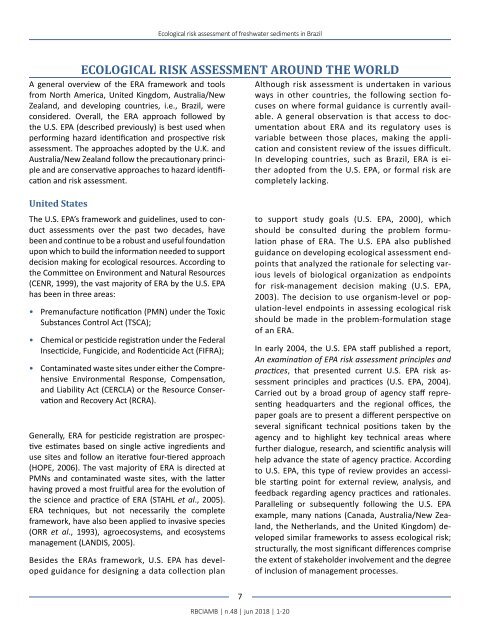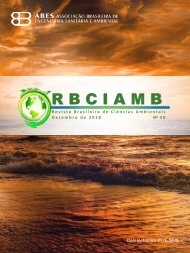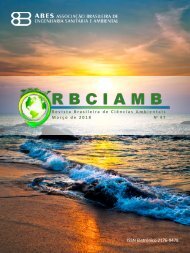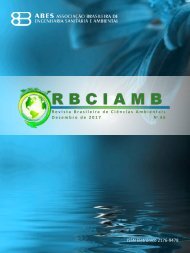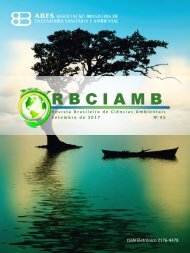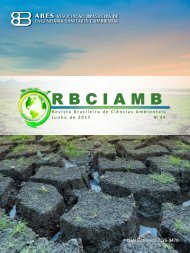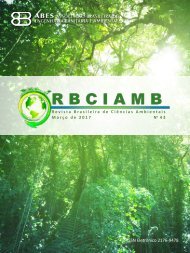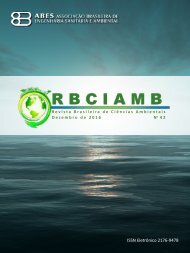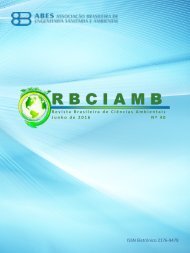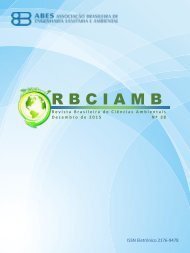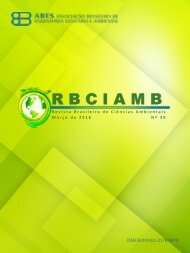Edição 48 RBCIAMB
Create successful ePaper yourself
Turn your PDF publications into a flip-book with our unique Google optimized e-Paper software.
Ecological risk assessment of freshwater sediments in Brazil<br />
ECOLOGICAL RISK ASSESSMENT AROUND THE WORLD<br />
A general overview of the ERA framework and tools<br />
from North America, United Kingdom, Australia/New<br />
Zealand, and developing countries, i.e., Brazil, were<br />
considered. Overall, the ERA approach followed by<br />
the U.S. EPA (described previously) is best used when<br />
performing hazard identification and prospective risk<br />
assessment. The approaches adopted by the U.K. and<br />
Australia/New Zealand follow the precautionary principle<br />
and are conservative approaches to hazard identification<br />
and risk assessment.<br />
Although risk assessment is undertaken in various<br />
ways in other countries, the following section focuses<br />
on where formal guidance is currently available.<br />
A general observation is that access to documentation<br />
about ERA and its regulatory uses is<br />
variable between those places, making the application<br />
and consistent review of the issues difficult.<br />
In developing countries, such as Brazil, ERA is either<br />
adopted from the U.S. EPA, or formal risk are<br />
completely lacking.<br />
United States<br />
The U.S. EPA’s framework and guidelines, used to conduct<br />
assessments over the past two decades, have<br />
been and continue to be a robust and useful foundation<br />
upon which to build the information needed to support<br />
decision making for ecological resources. According to<br />
the Committee on Environment and Natural Resources<br />
(CENR, 1999), the vast majority of ERA by the U.S. EPA<br />
has been in three areas:<br />
• Premanufacture notification (PMN) under the Toxic<br />
Substances Control Act (TSCA);<br />
• Chemical or pesticide registration under the Federal<br />
Insecticide, Fungicide, and Rodenticide Act (FIFRA);<br />
• Contaminated waste sites under either the Comprehensive<br />
Environmental Response, Compensation,<br />
and Liability Act (CERCLA) or the Resource Conservation<br />
and Recovery Act (RCRA).<br />
Generally, ERA for pesticide registration are prospective<br />
estimates based on single active ingredients and<br />
use sites and follow an iterative four-tiered approach<br />
(HOPE, 2006). The vast majority of ERA is directed at<br />
PMNs and contaminated waste sites, with the latter<br />
having proved a most fruitful area for the evolution of<br />
the science and practice of ERA (STAHL et al., 2005).<br />
ERA techniques, but not necessarily the complete<br />
framework, have also been applied to invasive species<br />
(ORR et al., 1993), agroecosystems, and ecosystems<br />
management (LANDIS, 2005).<br />
Besides the ERAs framework, U.S. EPA has developed<br />
guidance for designing a data collection plan<br />
to support study goals (U.S. EPA, 2000), which<br />
should be consulted during the problem formulation<br />
phase of ERA. The U.S. EPA also published<br />
guidance on developing ecological assessment endpoints<br />
that analyzed the rationale for selecting various<br />
levels of biological organization as endpoints<br />
for risk-management decision making (U.S. EPA,<br />
2003). The decision to use organism-level or population-level<br />
endpoints in assessing ecological risk<br />
should be made in the problem-formulation stage<br />
of an ERA.<br />
In early 2004, the U.S. EPA staff published a report,<br />
An examination of EPA risk assessment principles and<br />
practices, that presented current U.S. EPA risk assessment<br />
principles and practices (U.S. EPA, 2004).<br />
Carried out by a broad group of agency staff representing<br />
headquarters and the regional offices, the<br />
paper goals are to present a different perspective on<br />
several significant technical positions taken by the<br />
agency and to highlight key technical areas where<br />
further dialogue, research, and scientific analysis will<br />
help advance the state of agency practice. According<br />
to U.S. EPA, this type of review provides an accessible<br />
starting point for external review, analysis, and<br />
feedback regarding agency practices and rationales.<br />
Paralleling or subsequently following the U.S. EPA<br />
example, many nations (Canada, Australia/New Zealand,<br />
the Netherlands, and the United Kingdom) developed<br />
similar frameworks to assess ecological risk;<br />
structurally, the most significant differences comprise<br />
the extent of stakeholder involvement and the degree<br />
of inclusion of management processes.<br />
7<br />
<strong>RBCIAMB</strong> | n.<strong>48</strong> | jun 2018 | 1-20


